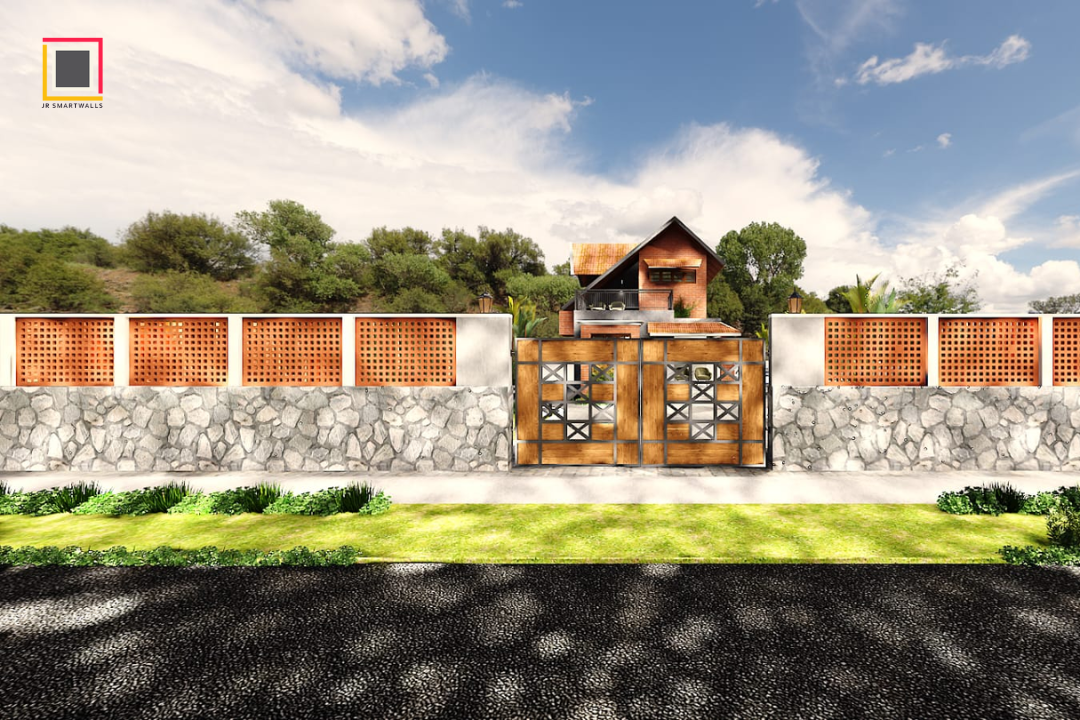What are RCC boundary walls?
The boundary walls made with RCC (Reinforced Cement Concrete) are called RCC boundary walls. Precast RCC boundary walls are made using precast concrete panels or elements constructed off-site; the compound wall panels are then taken to the construction sites for assembly. The walls are built and fabricated as barriers or boundaries in estates, homes, or certain regions.
Precast concrete products are usually made by casting concrete in reusable moulds or forms; here, we use specially-made rubber moulds for making precast compound walls. Once the concrete is added to the mould, it will be placed into the concrete vibrating table for vibrating the compound walls. It helps to fill the air bubbles or gaps in the compound walls. After the entire process, the precast concrete walls or panels will be transported to the site and assembled by connecting them. Our experts will make it possible in an easy way.

What are the benefits of RCC boundary walls?
Time-saving installation: we know that precast panels or precast RCC boundary wall designs are manufactured off-site, and the installation process is quicker than the traditional onsite construction methods. It can lead to the precast compound walls becoming a time-saving process.
Consistent quality: here, precast concrete compound walls are made with rubber moulds, which can ensure uniformity in quality, strength and finishing. It makes the overall durability of precast concrete compound walls more than that of traditional onsite constructed compound walls.
Customization: Precast boundary walls offer flexible custom designs. We can easily cast precast compound walls with custom designs. It is very easy to cast custom designs in precast compound walls with rubber moulds.
Durability and strength: Precast RCC boundary walls are more popular for their strength and durability. Due to the usage of concrete mix and vibrating tables for vibrating combinations to fill the air gaps or bubbles, the precast concrete boundary walls are more durable and long-lasting than the regular compound walls. Stable and durable behavior combined with a custom design makes precast compound walls more attractive and famous.
Security and Privacy: We know that the precast RCC boundary walls are strong and durable; they also provide protection and privacy for our properties by restricting unwanted visits from strangers and creating a perfect distance from all.
Space saving: Precast compound walls are a space-saving method. While considering the traditional compound walls, it may take more space and base. However, precast compound walls will not take up much space like traditional compound walls.
Ease of Maintenance: Precast RCC boundary walls require minimal maintenance compared to other wall types. Regular cleaning and occasional inspections suffice to keep the walls in good condition.
The benefits of precast RCC boundary walls are much more than those of traditional compound walls. Precast compound walls include efficiency in construction, consistent quality, a time-saving process, custom designs, long-lasting and durable materials, and space-saving methods. Precast compound walls are the best choice for property owners.

Difference between RCC boundary walls and traditional boundary walls
Compound walls that are traditional in design are generally constructed on-site using construction materials such as blocks, stones, and concrete blocks. The construction process is manual, which involves the construction of materials in a row, laid out, and then bonded with masons or other workers. This process requires excavation, foundation-laying block/brick placement as well as mortar application. Ending with the application of paint or plaster.
However, precast RCC (Reinforced Cement Concrete) wall borders are made on-site at specialized factories or facilities. The walls are made in molds that contain reinforcement steel and top-quality concrete mixes. When the segments or panels are finished, they’re taken to the location for installation.
Construction Process: Traditional walls are built manually on site, which involves multiple steps of building. Precast RCC walls are manufactured off-site; they only require transportation and installation.
Qualitative and Consistent: Traditional walls: Their quality is dependent on the abilities of employees, the consistency of materials, and the quality of artistry. These will be different. Precast RCC walls: Made under controlled conditions to ensure the same quality and integrity of the structure.
Time and Labor: Traditional walls are time-consuming because of construction on site that requires additional labor and delays that the weather or any other factor could cause. Precast RCC walls: faster installation because the panels are already made, which reduces labor on site and the amount of time.
Stability and Durability: The strength of traditional walls varies depending on the building materials and the quality of construction and may differ in terms of durability. Precast RCC walls are generally robust and durable thanks to the controlled manufacturing process and premium materials.
Cost: Traditional walls: The cost of construction can be different based on materials as well as labor costs and other elements. Precast RCC walls: The initial cost could be more expensive due to the manufacturing process. However, long-term advantages regarding the durability of the walls and the lower cost of maintenance can offset the cost.
FAQ
Why should you choose to build compound walls over ordinary walls?
The compound walls offer many benefits over regular barriers, such as low maintenance costs and easy installation across an ample space, high quality and long durable life span, appealing design, and quick duration. Compared to standard walls, boundary walls can be profit-making as high as 60%.
What makes JR smart walls unique?
JR smart walls differ from other walls because the moulds of rubber that are used for the production of JR smart walls are cast only to be used for boundary wall precast designs, which provide a good finish with a firm, attractive and durable design. The moulds that we use are high-quality because the rubber that is used to create the rubber moulds used for compound wall precast is sourced from our native in Kerala, India. Unique designs, as well as the specially cast rubber moulds, make JR smart walls different in comparison to other walls.
Advantages of precast compound walls
- Customized design with aesthetic appeal
- Three times more durable than the conventional method
- Strength – made with M30 concrete, AR fiberglass
- Finish – unmatched finishing with rubber moulds, better finishing than handwork
- Dimensional stability – as it is cast with moulds
- Consistent quality
- Time-saving installation
- Less space consuming
- Reduced maintenance
- Versatility of applications
- Fire, termite, weather resistant
What is the purpose of precast compound walls?
The precast compound walls block traffic and block out strangers through our personal space. The privacy and security of our daily lives are more than just a matter of walls aiding us. Precast compound walls help bring it to life in a very short period and at a cost-effective price.
How are precast compound walls made?
Precast concrete that has been poured into a reusable JR-made rubber mold that can be specially cast to make wall precasting; after it has completed the filling of concrete, the mould will be put in the vibrating table to vibrate, which assists in removing air bubbles that are present in the concrete. Precast compound walls have an excellent finish.
What makes concrete walls the best in the world of compound walls?
Concrete stands strong and tall when considering other compound wall materials. The unmatched durability, versatility, and affordability make house owners, contractors, and builders choose concrete walls. Concrete boundary walls are fire, termite, and weather-resistant; precast compound walls will last longer than traditional ones. Concrete boundary walls are cost-effective, time-saving installation, easy to make custom designs, sturdy and durable, unmatched finishing than the hand made boundary walls. These features of concrete boundary walls make them more popular in the field of compound walls.


